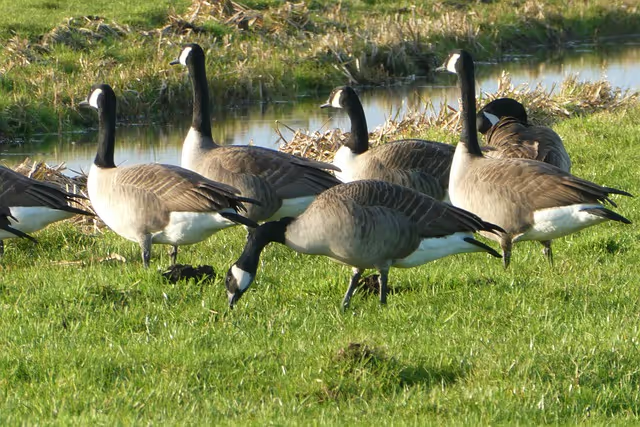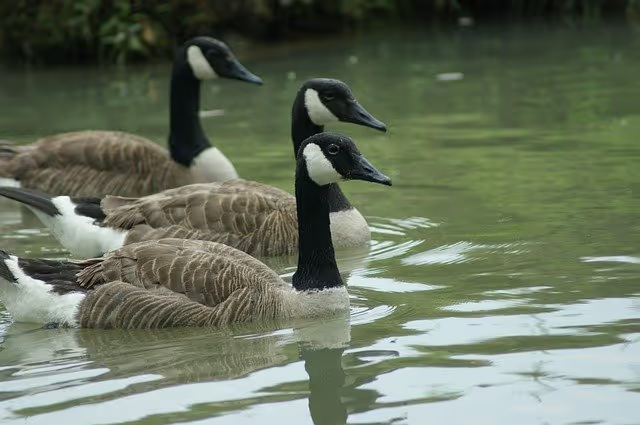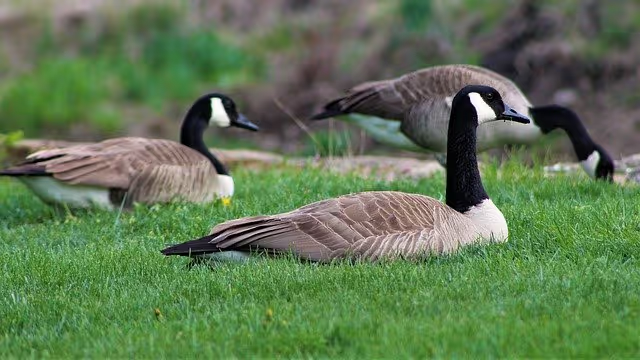Canada Geese



Canada Geese, often referred to as Canadian Geese, are quite possibly the most common type of goose found here in Western Washington. They live in many habitats, including those near water, grain fields, and grassy fields. As a result, you will often see them in local parks that are on the water and have grassy fields. You might also see them on golf courses and at airports, which also have large, grassy fields. If you have a home located adjacent to or near a body of water, you might even see them on your lawn. Canada Geese love lawns because they can digest grass easily, and, when they have their young in tow, lawns provide a wide view of any predators that may be approaching.
In the spring and summer months, the diet of Canada Geese consists mainly of grasses and sedges, including eelgrass and skunk cabbage. In the fall and winter months, their diet shifts to be more reliant on seeds and berries, including agricultural grains, blueberries (which is said to be one of their absolute favorite foods). and kernels from dry corn cobs. almost entirely plant material. Other foods that Canada Geese like to eat include cultivated grains, insects, mollusks, and crustaceans.
Canada Geese build their nests on the ground. They generally build them on muskrat mounds or other sites that are slightly elevated and close to water. They prefer a spot where their view is largely unobstructed in many different directions. The female goose selects the site and handles most of the construction of the nest. The nest is in the shape of an open cup, and is made of lichens, mosses, dry grasses, and other plant materials. She adds down feathers and a few body feathers once the second egg is laid. Her mate guards both her and the nest, allowing her to focus on the incubation, which she handles by herself. The incubation period lasts for almost a month. The total nesting period is closer to fifty days in length. A pair of Canada Geese will lay anywhere from two to eight eggs. Each egg is 3.3 inches long (8.3 centimeters) and 2.2 inches wide (5.6 centimeters). The eggs are creamy white in color.

Goslings are born with their eyes open, and are covered with yellowish colored down. They leave the nest when they are just one or two days old. You might think that is far too soon to be leaving the nest. However, Canada Geese can walk, feed, swim, and even dive at that young age, so it's not a big concern. Furthermore, they have enough energy remaining in their yolk sac to survive for two days before they have to feed, which gives them time to adjust to their surroundings. Soon after they hatch, goslings begin pecking at small objects, and spend the majority of their time feeding and sleeping. They mostly remain with their parents constantly, although “gang broods” do form from time to time. This happens mainly in Southern latitudes, so you aren't likely to see a "gang brood" here in the Pacific Northwest. When "gang broods" do form, they can include two to five (sometimes more) broods that feed, loaf, and travel together. All broods are accompanied by no less than one adult. The young often remain with their parents for their entire first year. As summer turns to fall, they become more social. They may gather in large number at food sources. If the food supply is limited. they may compete for it with displays and fights.
Canada Geese spend a lot of time tipped forward. They have to do this in order to eat and drink. During much of the year, they hang out in large flocks. Most of the birds in a particular flock may be related to one another, but this isn't always the case. Once a pair is formed, they generally mate for life (some pairs do get "divorced", but this is a rare occurrence), and remain together all throughout the year. Geese mate in an assortative matter. This means that larger birds typically choose larger mates, and smaller birds tend to go for smaller mates. In any given pair, the male is generally larger than the female. Most Canada Geese do not breed until their fourth year together. Less than ten percent of Canada Geese breed as yearlings, and most pair bonds aren't stable until the birds are at least two or three years old. As anyone who has ever dated knows, it takes time to find that special someone. Apparently, Canada Geese know this as well.
During the spring months, pairs of Canada Geese break out from their flocks and begin defending territories. How spaced out these pairs are varies depending on population density and the availability of nesting sites. In areas where the population is large, birds may end up nesting within sight of one another, and some populations are even "semi-colonial." However, these events don't happen without plenty of bird fights taking place first. When Canada Geese feel threatened, they pump their heads, open their bills, raise their tongues, honk, hiss, and vibrate their neck feathers. , When an intruding goose doesn’t promptly retreat, geese may grab each other by the breast or throat and hit each other with their wings.
Canada Geese are large water birds. They have long necks, large bodies, large webbed feet, and wide, flat bills. Geese of both sexes are typically 29.9. to 43.3 inches (76 to 110 centimeters) long with a wingspan of 50 to 66.9 inches (127 to 170 centimeters). They weigh 105.8 to 317.5 ounces (3,000 to 9,000 grams). Canada Geese have black heads with white cheeks and chinstraps. Their backs are brown, their breasts are tan colored, and their necks are black.

Canada Geese who breed in the northernmost reaches of their range will normally migrate long distances to spend the winter in the more southerly parts of the range. Here in the Pacific Northwest, some geese migrate and others don't. The reason for that appears to be that newer populations of Canada Geese have no childhood memories of hatching from nests in Northern Canada because their breeding range has expanded south into our neck of the woods. The range expanded south after the largest representatives of the Canada Geese family of birds, Branta canadensis maxima, nearly became extinct in the early part of the twentieth century. Efforts to re-establish the species were wildly successful, which led to some areas becoming overcrowded. The overflow from these areas caused geese to fly south in search of their own territory, which brought them to our corner of the world. Therefore, if the geese decide to migrate, they don't have to go as far because temperatures are warmer here than they are in Northern Canada. Migrating flocks tend to include loose aggregations of family groups and individuals. Flights usually begin at dusk, but can start at any time as Canada Geese fly at all hours of the day and night. They move in a V-shaped formation, with experienced individuals taking turns leading the flock.
In an upcoming post, we'll talk about a bird species that is so similar to the Canada Geese we've explored here that you've probably seen one or two while looking at Canada Geese and didn't realize it: The Cackling Goose. See you soon!
References
© Ian D. Caldwell, January 2021
Touch whale bones, examine shipwreck artifacts and connect with the coast's living history.

Support our mission, get involved in educational programs, or contribute through donations and volunteering.